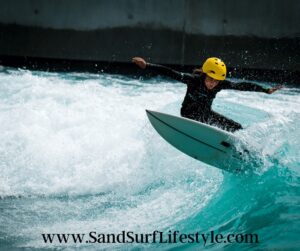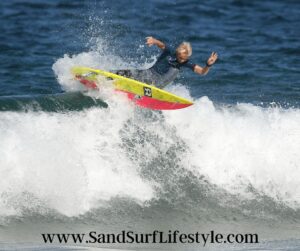As we all head out to the beaches for our favorite hot-weather activities, you might be seeing a lot of people on all different types of surfboards—including kids. What kind of surfboard are they using?
But what is a “grom”? Why are they beneficial to younger or smaller surfers? What are more of the differences? What should a beginner surfer know before heading out onto the waves? Read on to find out more about this extreme sport.
What is a “grom”?
 A “grom,” a “Grommet,” or a “Gremmie” are all terms for a younger surfer. Although it started out as just a reference to those under sixteen participating in the sport, it has expanded since then to include any younger participant in any extreme sport.
A “grom,” a “Grommet,” or a “Gremmie” are all terms for a younger surfer. Although it started out as just a reference to those under sixteen participating in the sport, it has expanded since then to include any younger participant in any extreme sport.
The first known use of the term was in 1964, in an article in the Times where the journalist called a surfer just starting out a “gremmie” and since then it has been used to describe an inexperienced surfer.
The word originally came from the term “gremlins,” or how the younger generation acted after going to the beach.
Another origin of the word was from “grommet” or the nickname for the lowest ranking member of a ship in the navy. Taken over by the Australian surf community, it became a word to describe younger—but skilled—surfers.
Why is a grom surfboard used?
A grom surfboard is most suited for younger, smaller surfers, and is built in a way that allows a child to learn and adapt when starting out surfing. Most grom surfboards focus on volume and width so a new surfer has more stability when learning to paddle and float, along with popping up and easily standing.
Regardless of what size or brand a child starts out with, there are a few things to note about the surfboard before purchasing. Firstly, the longer the surfboard, the better the stability. It also allows for easier paddling and catching smaller waves.
Secondly, the fuller the shape, the better. Although grom surfboards need to be thinner for a child to grab on to, make sure it’s the fullest you can go, because the wide board provides better stability, allowing the child to pop up easier.
Thirdly, the board should be thicker. The thicker the board, the more volume you have to float on. This also helps the surfer catch more waves.
Boards to avoid when starting out are shorter, narrower surfboards since they are less stable; thinner or lighter boards, because they do not have the volume to hold up the surfer; and any board that is hard to paddle.
Do you know what the rail on a surfboard does? Find out here.
What are the differences between a grom surfboard and a standard surfboard?
 When learning to surf, a smaller child needs to have a board that is one foot to two feet longer than their height. As mentioned before, their board also is skinnier—no more than 20 inches in length.
When learning to surf, a smaller child needs to have a board that is one foot to two feet longer than their height. As mentioned before, their board also is skinnier—no more than 20 inches in length.
When comparing the traditional longboard to a grom board, adults typically start out on a longboard due to their higher buoyancy and stability. Their size, however, is too large for a smaller surfer, and their volume does not support a child the way a grom surfboard can. They are specifically made to give the child just enough volume to keep them above the water.
Because head injuries are a huge concern when losing a surfboard, most grom boards have some sort of outer covering, typically foam. Sometimes referred to as “foamies,” these soft-topped boards have a soft top layer rather than the hard fiberglass of a longboard. These tops are very durable, so your board should not be damaged.
Most surfboards are made of polyurethane or epoxy; it’s better for a new surfer to have a board made of epoxy due to its buoyancy and durability. They are much easier to paddle and also float, making them fantastic for a new surfer. Polyurethane, on the other hand, is less buoyant and heavier, but they have more flex to them and are more easily damaged. More advanced surfers tend to lean towards polyurethane because of that flex.
A grom board also has a flat rocker and smaller fin than other boards. Because kids quickly grow, grom surfboards are cheaper than the standard surfboard.
Getting Out on the Waves
 Learning to surf may seem like a daunting task but knowing what you need before you even go out onto the waves is key.
Learning to surf may seem like a daunting task but knowing what you need before you even go out onto the waves is key.
As you or your child is starting out, remember that you should not learn by yourself. Find a teacher or class that you can take to get down the basics of surfboarding. Don’t try to surf any large waves until you can conquer the smaller ones and stay out of the way of the more advanced surfers as you learn.
Learn how to surf before you head out into the water—there is no harm in practicing on the beach, and many teachers will start you out on dry land. Learning to shuffle your feet and popping up onto your board is much easier with solid ground under you, and will only get harder as you get out onto the unpredictable waves!
Finding the proper-sized surfboard for you or the child in your life doesn’t have to be hard—there are plenty of ways to determine what length, width, and volume your child might need to start out on the waves!
As you start your journey into the grom life, make sure you focus on safety—children should be aware of the safety issues when starting out surfboarding, along with already being a strong swimmer. Make sure they have the right gear, not just their grom surfboard, but the right wetsuit before they start. Sunscreen is also a must when they’re out on the beach. They’ll be carving the waves before they know it!
Please note: This blog post is for educational purposes only and does not constitute legal or medical advice. Please consult a legal expert or medical professional to address your specific needs.

